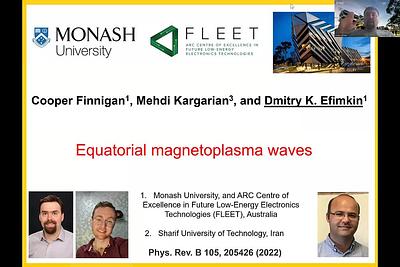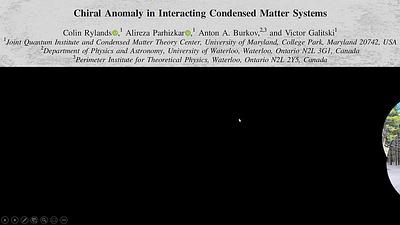By: Andrey Grankin and all
This work reviews our recent theoretical ideas along with related experimental results related to engineering non-equilibrium protocols and electromagnetic environments to enhance superconductivity in solid-state materials. First, I'll discuss a generalization of the Kennes, Millis et al's protocol of using phonon squeezing to strongly enhance superconducting Tc, in particular close to the dynamical lattice instabilities caused by driving. Se... more
This work reviews our recent theoretical ideas along with related experimental results related to engineering non-equilibrium protocols and electromagnetic environments to enhance superconductivity in solid-state materials. First, I'll discuss a generalization of the Kennes, Millis et al's protocol of using phonon squeezing to strongly enhance superconducting Tc, in particular close to the dynamical lattice instabilities caused by driving. Second, I will briefly review recent ideas of using cavity structures to engineer electromagnetic environments more favorable to superconductivity compared to materials in free space. Finally, I will zero in on hyperbolic metamaterial structures, which have been experimentally shown to strongly enhance superconducting Tc and the critical magnetic field in various compounds. These effects are usually attributed to hyperbolic plasmons, but I will argue that the conventional theory is probably unreliable. Based on our work in progress, I will speculate that it is likely boundary phonons that help bootstrap superconductivity in such systems. However, at the moment the nature of enhancement of superconductivity in hyperbolic metamaterials remains a bit of a mystery. less
By: Mehdi Kargarian
Integer quantum Hall effect, Chern insulators, topological insulators, and
topological superconductors are famous examples of topological phases
in noninteracting or weakly correlated electron systems. In these states
the ground state is nondegenerate and the excitations carry the original quantum
numbers. Fractional quantum Hall effect (FQHE) and spin liquids, on the other hand, arise
in strongly correlated electron systems an... more
Integer quantum Hall effect, Chern insulators, topological insulators, and
topological superconductors are famous examples of topological phases
in noninteracting or weakly correlated electron systems. In these states
the ground state is nondegenerate and the excitations carry the original quantum
numbers. Fractional quantum Hall effect (FQHE) and spin liquids, on the other hand, arise
in strongly correlated electron systems and exhibit exotic properties such as
ground state degeneracy and fractionalized excitations, dubbed as topologically ordered states,
with potential applications in quantum computations. While there are many material candidates for noninteracting topological phases of matter, the topological orders usually arise in texteme conditions such as strong magnetic fields and low temperatures, e.g., in FQHE, and in spin liquids, usually the extra interactions between spins spoil the realization of true topological orders.
Here, we ask the following question: Can we design the topological orders in
more conventional systems by properly coupling the degrees of freedom together? we try to present an understanding of one of the simplest topological orders, the Wen plaquette model, in a superconducting lattice model. Then, we discuss how one may obtain more exotic topological orders. less
Spin-plasma waves
2upvotes
By: Dmitry Efimkin and Mehdi Kargarian
The surface of a topological insulator hosts Dirac electronic states with the spin-momentum locking, which constrains spin orientation perpendicular to electron momentum. As a result, collective plasma excitations in the interacting Dirac liquid manifest themselves as coupled charge- and spin-waves. Here we demonstrate that the presence of the spin component enables effective coupling between plasma waves and spin waves at interfaces between ... more
The surface of a topological insulator hosts Dirac electronic states with the spin-momentum locking, which constrains spin orientation perpendicular to electron momentum. As a result, collective plasma excitations in the interacting Dirac liquid manifest themselves as coupled charge- and spin-waves. Here we demonstrate that the presence of the spin component enables effective coupling between plasma waves and spin waves at interfaces between the surface of a topological insulator and insulating magnet. Moreover, the helical nature of spin-momentum locking textures provides the phase winding in the coupling between the spin and plasma waves that makes the spectrum of hybridized spin-plasma modes to be topologically nontrivial. We also show that such topological modes lead to a large thermal Hall response. less
Equatorial magnetoplasma waves
2upvotes
By: Cooper Finnigan, Mehdi Kargarian, Dmitry K. Efimkin
Due to its rotation, Earth traps a few equatorial ocean and atmospheric waves, including Kelvin, Yanai, Rossby, and Poincare modes. It has been recently demonstrated that the mathematical origin of equatorial waves is intricately related to the nontrivial topology of hydrodynamic equations describing oceans or the atmosphere. In the present work, we consider plasma oscillations supported by a two-dimensional electron gas confined at the surfa... more
Due to its rotation, Earth traps a few equatorial ocean and atmospheric waves, including Kelvin, Yanai, Rossby, and Poincare modes. It has been recently demonstrated that the mathematical origin of equatorial waves is intricately related to the nontrivial topology of hydrodynamic equations describing oceans or the atmosphere. In the present work, we consider plasma oscillations supported by a two-dimensional electron gas confined at the surface of a sphere or a cylinder. We argue that in the presence of a uniform magnetic field, these systems host a set of equatorial magnetoplasma waves that are counterparts to the equatorial waves trapped by Earth. For a spherical geometry, the equatorial modes are well developed only if their penetration length is smaller than the radius of the sphere. For a cylindrical geometry, the spectrum of equatorial modes is weakly dependent on the cylinder radius and overcomes finite-size effects. We argue that this exceptional robustness can be explained by destructive interference effects. We discuss possible experimental setups, including grains and rods composed of topological insulators (e.g., Bi2Se3) or metal-coated dielectrics (e.g., Au2S). less
By: Noam Schiller, Barak A. Katzir, Ady Stern, Erez Berg, Netanel H. Lindner, Yuval Oreg
Systems harboring parafermion zero-modes hold promise as platforms for topological quantum computation. Recent experimental work (Gül et al., arXiv:2009.07836) provided evidence for proximity-induced superconductivity in fractional quantum Hall edges, a prerequisite in proposed realizations of parafermion zero-modes. The main evidence was the observation of a crossed Andreev reflection signal, in which electrons enter the superconductor from ... more
Systems harboring parafermion zero-modes hold promise as platforms for topological quantum computation. Recent experimental work (Gül et al., arXiv:2009.07836) provided evidence for proximity-induced superconductivity in fractional quantum Hall edges, a prerequisite in proposed realizations of parafermion zero-modes. The main evidence was the observation of a crossed Andreev reflection signal, in which electrons enter the superconductor from one chiral mode and are reflected as holes to another, counter-propagating chiral mode. Remarkably, while the probability for cross Andreev reflection was much smaller than one, it was stronger for $\nu=1/3$ fractional quantum Hall edges than for integer ones. We theoretically explain these findings, including the relative strengths of the signals in the two cases and their qualitatively different temperature dependencies. Beyond the coupling of the two counter-propagating modes through Andreev reflection and back-scattering, an essential part of our model is the coupling of the edge modes to normal states in the cores of Abrikosov vortices located close to the edges. These vortices are made dense by the magnetic field needed to form the quantum Hall states, and provide a metallic bath to which the edges are tunnel-coupled. The stronger crossed Andreev reflection in the fractional case originates from the suppression of electronic tunneling between the bath and the fractional quantum Hall edges. Our theory shows that the mere observation of crossed Andreev reflection signal does not necessarily imply the presence of localized parafermion zero-modes, and suggests ways to identify their presence from the behavior of this signal in the low-temperature limit. less
By: Alireza Parhizkar et al
The chiral anomaly is a fundamental quantum mechanical phenomenon which is of great importance to both particle physics and condensed matter physics alike. In the context of QED, it manifests as the breaking of chiral symmetry in the presence of electromagnetic fields. It is also known that anomalous chiral symmetry breaking can occur through interactions alone, as is the case for interacting one-dimensional systems. In this Letter, we invest... more
The chiral anomaly is a fundamental quantum mechanical phenomenon which is of great importance to both particle physics and condensed matter physics alike. In the context of QED, it manifests as the breaking of chiral symmetry in the presence of electromagnetic fields. It is also known that anomalous chiral symmetry breaking can occur through interactions alone, as is the case for interacting one-dimensional systems. In this Letter, we investigate the interplay between these two modes of anomalous chiral symmetry breaking in the context of interacting Weyl semimetals. Using Fujikawa’s path integral method, we show that the chiral charge continuity equation is modified by the presence of interactions which can be viewed as including the effect of the electric and magnetic fields generated by the interacting quantum matter. This can be understood further using dimensional reduction and a Luttinger liquid description of the lowest Landau level. These effects manifest themselves in the nonlinear response of the system. In particular, we find an interaction-dependent density response due to a change in the magnetic field as well as a contribution to the nonequilibrium and inhomogeneous anomalous Hall response while preserving its equilibrium value. less





